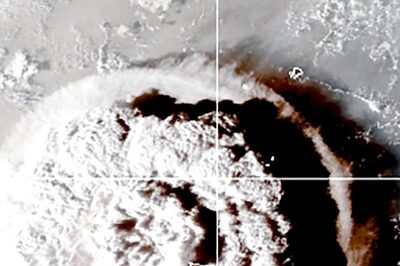
views
Tokyo: Smoke spewed Monday from two adjacent reactors in the Fukushima Daiichi nuclear power plant, a nuclear safety official said, setbacks that came despite fervent efforts to prevent the further release of radioactive materials at the stricken facility.
After 6 p.m., white smoke was seen emanating from the facility's No. 2 reactor, according to Hidehiko Nishiyama, an official with Japan's Nuclear and Industrial Safety Agency. About two hours earlier, workers were evacuated from the area around the No. 3 reactor after gray smoke began to rise from the wreckage of its steel-and-concrete housing, which was blown apart by a hydrogen explosion last week.
The No. 3 reactor has been the top priority for authorities trying to contain damage to the plant and stave off a possible meltdown. Its fuel includes a small percentage of plutonium mixed with the uranium in its fuel rods, which experts say could cause more harm than regular uranium fuels in the event of a meltdown.
Nishiyama said there was no evident explosion, spike in radiation or injuries at the No. 3 reactor. The smoke was coming from the building's southeastern side, where the reactor's spent nuclear fuel pool is located, but the origin of the smoke at either reactor was unknown.
The coolant pools contain spent fuel rods that still generate high amounts of heat, and authorities have been working to keep them full to prevent the rods from being exposed. NISA estimated that, between roughly 9 p.m. Sunday to 4 a.m. Monday, 1,170 tons of water were sprayed on the reactor and its fuel pool.
In Geneva, Switzerland, the head of the International Atomic Energy Agency warned that the plant "has been seriously damaged by flood water and is littered with debris."
"The crisis has still not been resolved, and the situation at the Fukushima Daiichi nuclear power plant remains very serious," Yukiya Amano, the director-general of the UN nuclear watchdog agency, told its board of governors Monday after a visit to the site.
"Buildings have been damaged by explosions," he said. "There has, for the most part, been no electric power. Radiation levels are elevated. It is no exaggeration to describe the work of the emergency teams as heroic."
The plant's owner, the Tokyo Electric Power Company, is trying to restore electricity to the damaged plant after it was hit by the massive earthquake and tsunami the struck northern Japan on March 11.
TEPCO told CNN on Monday that electrical cables had been laid to connect the No. 3 reactor and the neighboring No. 4 reactor with an outside power source.
That meant that power could now be funneled to all six of the plant's reactors for its cooling systems. But electricity was still not moving to units No. 1 through No. 4, because the quake and tsunami had damaged numerous pumps and other gear.
A Tokyo Electric official said that spare parts were being brought in, so that everything could work again.
CNN reporter reflects on tsunami damage Pouring tons of water on power plant
TEPCO official reports on power plant.
The disaster has killed more than 8,600 people and left more than 13,000 missing, many of them killed as a wall of water rushed following the quake. Ever since, authorities have been work to avert further crisis -- and prevent more deaths -- at the Fukushima Daiichi plant, some 240 kilometers (150 miles) north of Tokyo.
Those efforts include a move to possibly encase one or more of the reactors in concrete, a last-ditch effort similar to what was done after the 1986 meltdown at the Chernobyl nuclear plant in the former Soviet Union -- considered the worst nuclear disaster at a plant.
On Monday, an official with Japan's nuclear and industrial safety agency told reporters that tests are expected to be conducted in the afternoon on how to use what he called a "concrete pump engine."
The engine would pump a mix of mortar and water into the reactor's spent nuclear fuel pool and containment vessel, the official said. The pool contains nuclear fuel rods that could give off radioactive material, if exposed and overheated, while the containment vessel is a steel and concrete shell that insulates radioactive material inside.
While he did not indicate when or even if the concrete pump would be used, the official did say the target would be the plant's No. 4 reactor. In just over two hours on Monday morning alone, 13 fire engines sprayed about 90 tons of water toward that reactor in an attempt to cool it down.
A Tokyo electric official told CNN that six workers trying to restore electricity to that reactor have been exposed to more than 100 millisieverts of radiation. For reference, an individual in a developed country naturally is exposed to 3 millisieverts of radiation a year, though Japan's Ministry of Health, Labor, and Welfare has reset the exposure level upward to 250 millisieverts for those trying to combat the crisis at the Fukushima plant. That is 2.5 times the previous limit, according to the ministry.
These efforts came as concerns remained high about the impact that already emitted radiation has had on food, water and people within range of the Fukushima facility.
Very small amounts -- far below the level of concern -- of radioactive iodine have been detected in tap water in Tokyo and most prefectures near the plant. The health ministry said levels of radioactive iodine three times greater than the regulated standard were found in drinking water in a village near the plant and asked residents not to drink from the tap, Kyodo News reported Sunday.
The Japanese government has banned the sale of raw milk from Fukushima Prefecture, where the plant is located, and prohibited the sale of spinach from neighboring Ibaraki Prefecture after finding levels of radioactive iodine and cesium higher than government standards, the country's health ministry reported. And officials in Fukushima halted the distribution of locally grown vegetables outside the prefecture.
Edano said the contaminated milk detected in Fukushima Prefecture had not been distributed or sold.
On Saturday, officials said tainted milk was found 30 kilometers (18 miles) from the plant, and spinach was collected as far as 100 kilometers (65 miles) to the south, almost halfway to Tokyo. That prompted a statement of concern from the World Health Organization, which said early Monday that the spread of contamination was "more serious" than initially expected.
"It's new and something we're watching," WHO spokesman Peter Cordingley told CNN. But he said the reported levels of radioactivity posed no short-term health risk, and Japanese officials were taking a "very precautionary" stance.
"Nobody is seeing that there's an immediate health problem," Cordingley said.
The latest results accumulated and posted online by Japan's Education, Science and Technology Ministry showed slight but notable upticks in airborne radiation readings around Japan in recent days. But even the highest readings, .11 millisieverts some 30 kilometers northwest of the plant, were still considered significantly below what's considered dangerous to humans.
Nature has helped to minimize such airborne exposure since the quake, as winds from the northwest have blown many emissions from the plant out to sea. But the wind direction is expected to change through Wednesday, potentially pushing more of the material to the southwest and over land.
"People are watching," said Akira Shioi, who lives in Kawasaki. "And people have greater concern than ever about the nuclear power plant incident."

















Comments
0 comment